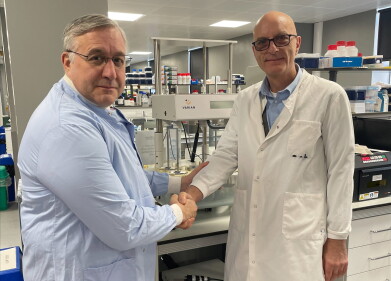-
 A chain of amino acids is captured, unfolded and translocated through an engineered protein nanopore. Changes in an electrical current applied across the nanopore detect post-translational modifications deep within the proteins (shown as circles, triangles, and hexagons). Image credit: Wei-Hsuan Lan and Yujia Qing
A chain of amino acids is captured, unfolded and translocated through an engineered protein nanopore. Changes in an electrical current applied across the nanopore detect post-translational modifications deep within the proteins (shown as circles, triangles, and hexagons). Image credit: Wei-Hsuan Lan and Yujia Qing -
.jpg) Yujia Qing (Credit: Yujia Qing)
Yujia Qing (Credit: Yujia Qing)
News
Enabling Technology enables Protein Variant Detection
Oct 11 2023
Research at the University of Oxford has led to a significant breakthrough in detecting modifications on protein structures by employing nanopore technology to identify structural variations at the single-molecule level, even deep within long protein chains.
Human cells contain approximately 20,000 protein-encoding genes, which then also generate variants following a process known as post-translational modification (PTM), which occurs after a protein has been transcribed from DNA.
Because PTM introduces structural changes, such as the addition of chemical groups or carbohydrate chains to the individual amino acids that make up proteins, there could be hundreds of possible variations for the same protein chain.
These variants play pivotal roles in biology, by enabling precise regulation of complex biological processes within individual cells and mapping this variation would uncover a wealth of valuable information that could revolutionise our understanding of cellular functions.
Now researchers at the University of Oxford’s Department of Chemistry have successfully developed a method for protein analysis based on nanopore DNA/RNA sequencing technology. In this approach, a directional flow of water captures and unfolds 3D proteins into linear chains that are fed through tiny pores, just wide enough for a single amino acid molecule to pass through. Structural variations are identified by measuring changes in an electrical current applied across the nanopore. Different molecules cause different disruptions in the current, giving them a unique signature.
The team successfully demonstrated the method’s effectiveness in detecting three different PTM modifications (phosphorylation, glutathionylation, and glycosylation) at the single-molecule level for protein chains over 1,200 residues long. These included modifications deep within the protein’s sequence. Importantly, the method does not require the use of labels, enzymes or additional reagents.
According to the research team, the new protein characterisation method could be readily integrated into existing portable nanopore sequencing devices to enable researchers to rapidly build protein inventories of single cells and tissues. This could facilitate point-of-care diagnostics, enabling the personalised detection of specific protein variants associated with diseases including cancer and neurodegenerative disorders.
Professor Yujia Qing, Department of Chemistry at Oxford, contributing author for the study said: ‘This simple yet powerful method opens up numerous possibilities. Initially, it allows for the examination of individual proteins, such as those involved in specific diseases. In the longer term, the method holds the potential to create extended inventories of protein variants within cells, unlocking deeper insights into cellular processes and disease mechanisms.’
The University’s Professor Hagan Bayley, also from the Department of Chemistry, a contributing author and co-founder of Oxford Nanopore Technologies, added: ‘The ability to pinpoint and identify post-translational modifications and other protein variations at the single-molecule level holds immense promise for advancing our understanding of cellular functions and molecular interactions. It may also open new avenues for personalised medicine, diagnostics and therapeutic interventions.’
Oxford Nanopore Technologies, a spinout company launched in 2005 based on Professor Bayley’s research, has become established as a front-runner in next-generation sequencing technologies. The company's patented nanopore technology enables scientists to sequence nucleic acids (DNA and RNA) quickly using portable, inexpensive devices – in contrast to standard sequencing, which typically requires dedicated laboratories. Oxford Nanopore devices have revolutionised fundamental and clinical genomics and played a critical role during the COVID-19 pandemic in helping to track the spread of new coronavirus variants.
This work was carried out in collaboration with the research group of mechanobiologist Sergi Garcia-Maynes at King’s College London and the Francis Crick Institute.The research findings were published in Nature Nanotechnology
More information online
Digital Edition
ILM 50.2 March 2025
March 2025
Chromatography Articles - Effects of small deviations in flow rate on GPC/SEC results Mass Spectrometry & Spectroscopy Articles - Waiting for the present to catch up to the future: A bette...
View all digital editions
Events
Mar 25 2025 Paris, France
Mar 27 2025 New Delhi, India
Mar 31 2025 Beijing, China
Microbiology Society Annual Conference 2025
Mar 31 2025 Liverpool, UK
Apr 01 2025 New York, USA

.jpg)





















